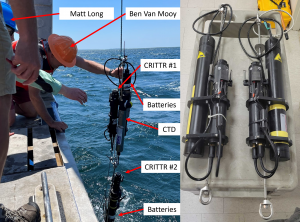CRISPEE CRITTR

Credit: Austin Greene
Constraining the metabolic fate of atmospheric carbon dioxide in the ocean – whether incorporated into biomass by photosynthesis, respired, or stored in the deep ocean – is fundamental to understanding the oceans’ role in global carbon cycling. We are developing a modular system for metabolic measurements from the 1) photic surface ocean where carbon is fixed using the Continuous Reconnaissance In-Situ Photosynthetic Ecosystem Explorer (CRISPEE), and 2) mesopelagic where carbon is metabolized at unknown rates in its long journey through the ocean depths using the Continuous Reconnaissance In-situ Twilight-zone Tiny Respirometer (CRITTR). Recently, we developed CRITTR protypes and proved its design concept in coastal waters. We are leveraging its modular design to enable photosynthetic carbon fixation measurements through CRISPEE. These small, economical CRISPEE-CRITTRs would enable a “fleet” of global rate measurements of photosynthesis and respiration throughout the ocean to inform global models and transform our understanding of oceanic carbon cycling.


